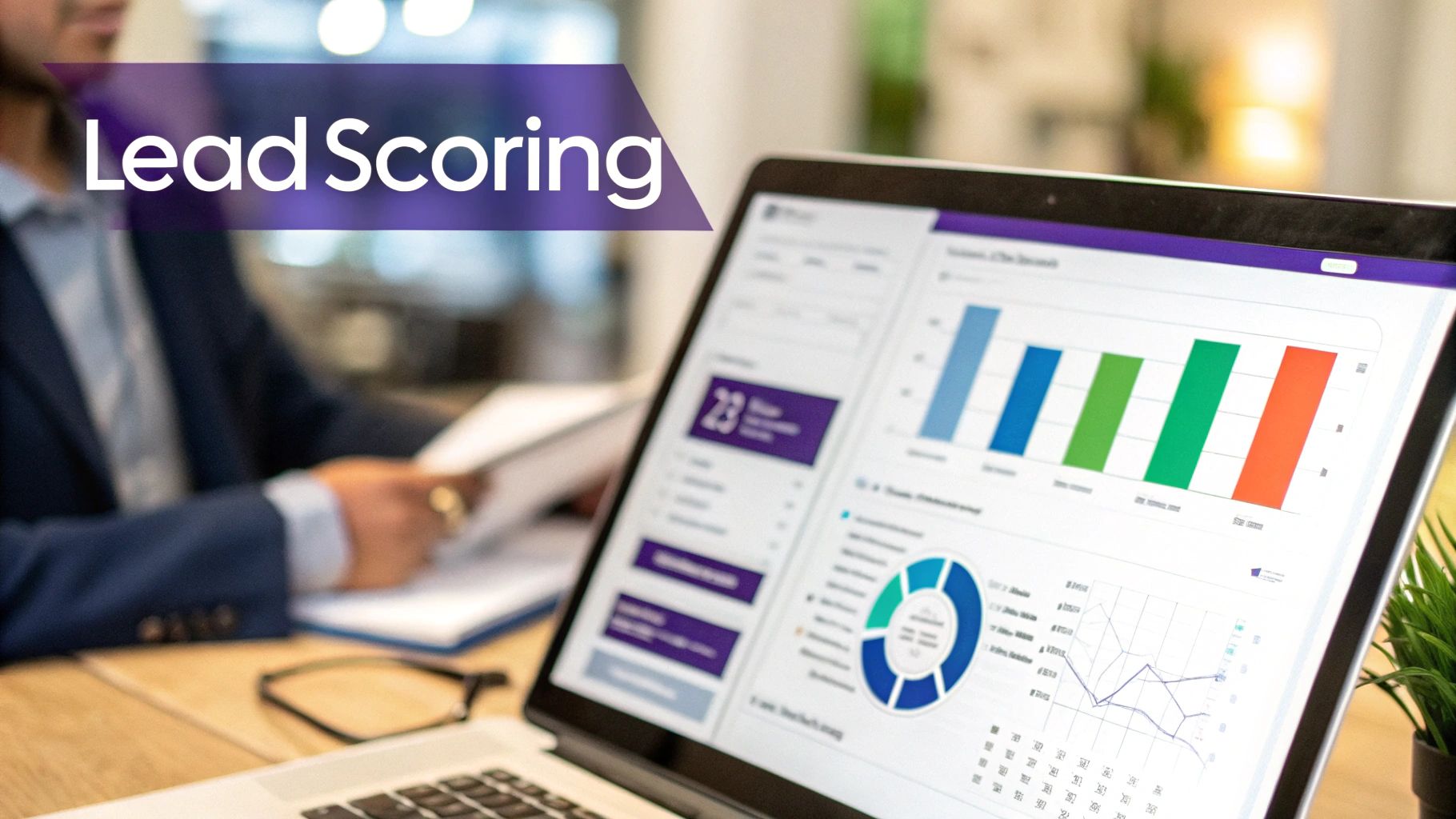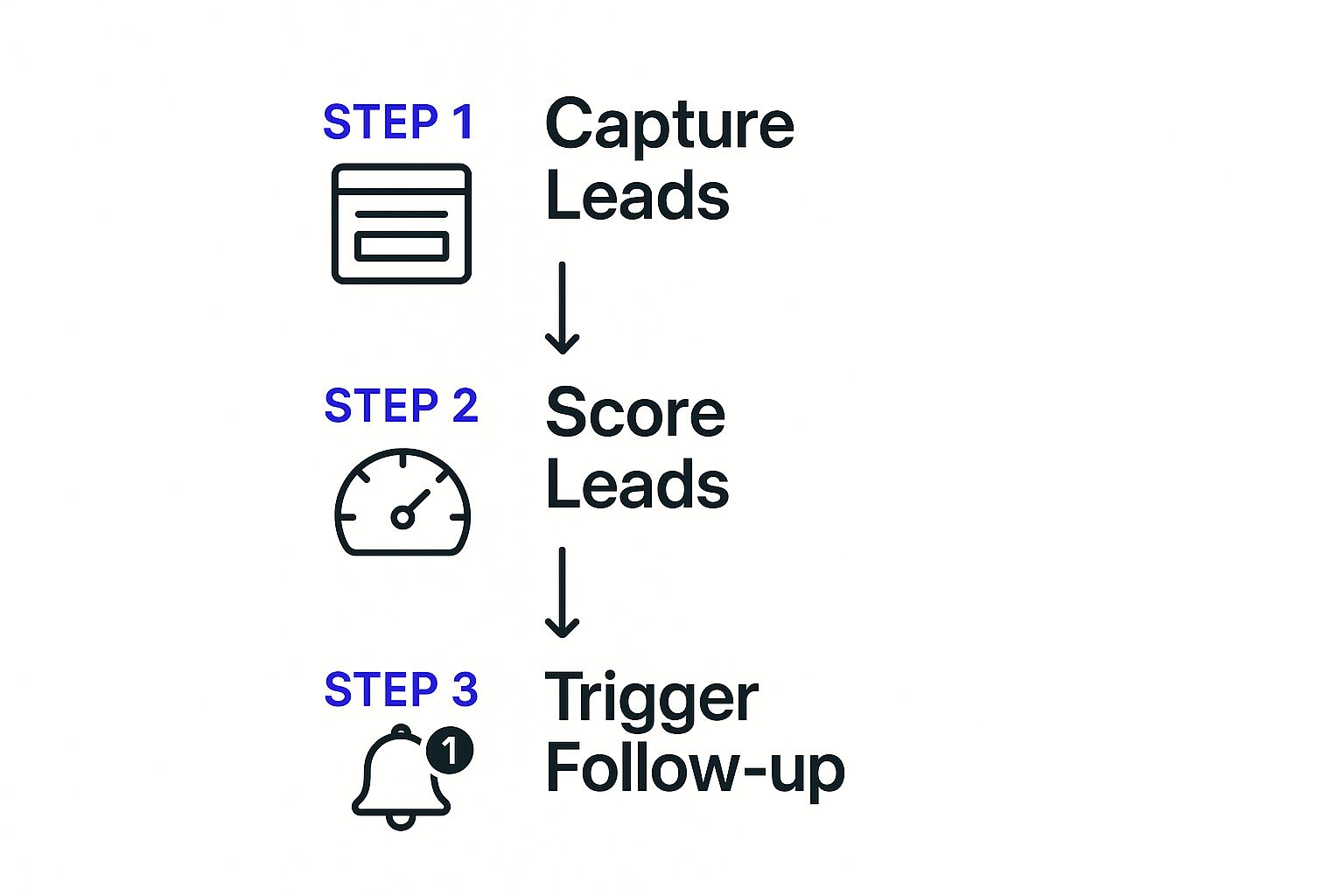Qualifying a sales lead is all about figuring out who's just browsing and who's ready to talk business. It’s the process of filtering your prospects to focus on those with a real need, the right budget, and the authority to make a purchase. This isn't just theory; it's the most practical way to stop wasting your team's valuable time and start closing more deals that actually stick.
Every seasoned sales professional has felt that sinking feeling. You pour weeks into nurturing what seems like a hot lead—countless calls, custom demos, detailed follow-ups—only to find out they can't get budget approval or, worse, they weren't the person who could say "yes" in the first place. This isn't just bad luck; it’s a symptom of a broken process.
This is exactly why a structured approach to how you qualify sales leads is a non-negotiable part of any successful sales operation.
Lead qualification isn't just another buzzword. Think of it as the bouncer for your sales pipeline, making sure only the high-potential buyers get in. It turns your sales process from a frustrating guessing game into a predictable, efficient machine. When you set clear criteria upfront, you give your team a roadmap to focus their energy where it will actually drive revenue.

Skipping this step comes with a hefty price tag. The data is pretty stark: a staggering 67% of lost sales can be traced directly back to poor (or nonexistent) lead qualification. On top of that, studies show that around 79% of marketing-generated leads never convert into sales. Why? Because most of them were never a good fit to begin with.
This isn't just about the deals you lose. It's about the massive opportunity cost. Every hour your team spends chasing a dead-end lead is an hour they could have spent building a relationship with a future top-tier client.
It’s time to ditch the "more is better" mentality for good. A pipeline bursting with unqualified leads gives a false sense of progress and is a fast track to team burnout. A truly high-performing sales engine is built on quality, not sheer volume.
A smaller, highly-qualified pipeline will always outperform a large, unfiltered one. It leads to shorter sales cycles, higher close rates, and more accurate sales forecasting.
Getting this right has a ripple effect across your entire business. Better lead qualification is a key piece of the puzzle when figuring out how to improve website conversion rates, as it ensures the traffic you're converting is actually valuable.
To really see the difference, let's look at what happens when a sales team gets serious about qualifying their leads.
The numbers in the table speak for themselves. This isn't just about incremental improvements; it's about a fundamental shift in how your team operates. A solid qualification system helps your people work smarter, not just harder, paving the way for sustainable growth and a much happier sales floor.
Before you even think about qualifying a single lead, you have to know exactly who you're looking for. It’s a common mistake to chase every form submission that comes through. That’s a fast track to a busy, but ultimately unproductive, sales team. It's like sailing without a map.
The real starting point for a killer qualification process is a rock-solid Ideal Customer Profile (ICP). This isn't just a fuzzy idea of your target market. It's a precise, data-backed blueprint of the company that gets the most value from what you sell—and gives you the most value in return.

The quickest way to figure out who you should be selling to is to look at who you’re already succeeding with. Think about your happiest, most profitable, and longest-retained clients. They hold the blueprint for your future growth.
Pull together a list of your top 10-15 customers. Once you have that, it's time to play detective and find the common threads that tie them together.
When you lay all this data out, patterns will jump out at you. You might realize your absolute sweet spot is B2B SaaS companies with 100-500 employees that just brought on their first Head of Sales. Now that’s an insight you can build a strategy around.
Hard data tells you the 'what,' but your team on the ground can tell you the 'why.' Your sales and customer success folks have a wealth of knowledge that can add real color and context to your ICP.
Set aside some time to chat with them. You don't need a formal interrogation, just a quick conversation.
Ask questions like:
This feedback is gold. It helps you get past the spreadsheets and understand the real-world pains your product solves, ensuring your ICP is grounded in reality.
Key takeaway: Your ICP isn't a "set it and forget it" document. Treat it as a living guide that you revisit at least quarterly. Markets shift, your product evolves, and your ICP needs to keep pace.
Once you’ve done the research, the final step is to create a clear, simple document—ideally just one page—that spells out your ICP. This becomes the North Star for your entire company, keeping marketing, sales, and even product development perfectly aligned.
When everyone is rowing in the same direction, you stop wasting resources. This focus makes your team far more efficient. And with modern tools, that efficiency gets a serious boost. For instance, 100% of sales professionals using AI assistants report saving at least one hour per week. When your AI knows exactly who you're looking for, it becomes exponentially more powerful.
You can dig into more data on how AI is changing the game in Outreach.io's 2025 analysis.
Think of established sales qualification frameworks as your GPS for a discovery call. They give you a proven roadmap. Frameworks like BANT, MEDDIC, and CHAMP provide a solid structure to make sure you’re hitting all the essential points you need to actually move a deal forward.
But here’s the critical part: they are guides, not rigid scripts. The moment a prospect feels like you're running through a checklist, you've lost them. The conversation should never feel like an interrogation.
Your real goal is to weave these concepts into a natural, two-way dialogue. You're not just ticking boxes; you're gently steering the conversation to uncover what's really going on in their world. This approach lets you gather crucial intelligence without making the other person feel like they're on the defensive.

BANT is a classic for a good reason—it’s straightforward and hits the core pillars of any deal: Budget, Authority, Need, and Timeline. The secret is asking questions that get you this information without sounding like you're reading from a textbook.
For example, a blunt "What's your budget?" is a conversation killer. Instead, try a more consultative approach.
When you're dealing with more complex, enterprise-level sales, MEDDIC provides a much more detailed map. It stands for Metrics, Economic Buyer, Decision Criteria, Decision Process, Implicate Pain, and Champion. This framework is all about digging into the real business impact and navigating the internal buying maze.
Let's see how you could apply a couple of its elements in a real call.
Key Insight: The difference between a good discovery call and a great one is getting past what the problem is and getting to so what? MEDDIC is designed to force you to quantify that pain.
To Implicate Pain, you could ask something like, "If this issue isn't resolved in the next six months, what are the downstream effects on other teams?" This question pushes the prospect to think beyond their immediate frustration and consider the broader consequences.
And for identifying the Economic Buyer, a great question is, "Who ultimately owns the P&L that a solution like this would impact?" This helps you pinpoint the person with the final say on the budget.
CHAMP is another fantastic framework that puts the prospect’s world first. It covers Challenges, Authority, Money, and Prioritization. It’s pretty similar to BANT, but it kicks off with the problem, which can help you build a much stronger connection right from the start.
At the end of the day, the best framework is the one your team actually understands and can use consistently. The goal isn't to become a robot who follows one model perfectly. It's about internalizing the principles behind them so you can guide conversations toward a clear outcome, ensuring you qualify sales leads effectively and build a pipeline full of real, winnable opportunities.
While qualification frameworks are fantastic for live conversations, let's be realistic—you can't manually vet every single person who downloads an ebook or browses your website. That's where lead scoring becomes your best friend. It’s essentially an automated system that assigns points to leads based on who they are and how they interact with your brand, letting you qualify sales leads at scale.
This process handles the initial heavy lifting, making sure your sales team’s valuable time is spent on conversations with real potential. A solid lead scoring system is what separates the casual browsers from those who are genuinely ready to talk business.
The cornerstone of any good lead scoring model is understanding the two types of data you’re working with. To get a complete picture of a lead’s quality, you need to assign points for both.
For example, a lead who fits your target industry might get 15 points right off the bat (explicit data). If they then download a key case study, you could add another 10 points (implicit data). These scores stack up, creating a clear priority ranking for your team.
Here's a look at how lead scoring fits into the bigger picture of capturing, qualifying, and following up with potential customers.

As you can see, scoring is that critical middle step. It's the engine that turns a long list of raw leads into a focused queue of actionable opportunities for your sales reps.
Once you’ve figured out how to assign points, you need to decide what those scores actually mean. This involves setting a clear threshold that, once a lead crosses it, automatically flags them as a Marketing Qualified Lead (MQL).
You might decide, for instance, that any lead who accumulates 100 points is officially sales-ready. That score becomes the trigger. It’s the signal that moves them out of marketing’s general nurture campaigns and straight into the sales team’s pipeline.
To give you a clearer idea, here’s what a simple scoring model might look like in practice.
This table is just a starting point, of course. The key is to customize the point values based on what signals a high-quality lead for your specific business.
Pro Tip: Don't carve your scoring rules into stone. I always recommend reviewing and tweaking your model at least once a quarter. Take a hard look at the leads that actually became customers. What did they have in common? Use those insights to refine your point values based on what truly drives results, not just what you think should work.
It's also smart to incorporate negative scoring. If a student downloads a whitepaper for research, you could subtract 20 points. If someone from a known competitor is poking around, maybe they get -50. This helps keep your pipeline clean and focused on legitimate prospects.
Finally, keep an eye out for Product Qualified Leads (PQLs). These are people who have actively used your product, maybe through a free trial or a freemium plan. Their actions speak louder than any form fill. In fact, a recent lead generation statistics report from Databox revealed that 46.4% of marketers now see PQLs as their highest-quality leads, ranking them well above traditional MQLs. Building product usage data into your scoring model can give you a serious competitive edge.
Your lead scoring system has done its job and handed you a promising prospect. They look good on paper, but now it's time for the real work to begin. The discovery call is where you move beyond data points and find out if there’s a genuine opportunity.
Think of it less as a sales pitch and more as an investigation. This is your chance to understand the human story behind the business problem. The single biggest mistake I see reps make is jumping straight into their pitch. Instead, your job is to shut up and listen. The goal is to build genuine rapport so the prospect feels comfortable sharing what’s really going on.
The quality of your discovery call hinges entirely on the quality of your questions. You need to go beyond the surface-level stuff marketing has already gathered and dig into their deep-seated pain points. Open-ended questions are your best friend here.
Here are a few questions I’ve found incredibly effective at shifting the conversation from a simple Q&A to a strategic discussion:
That last one is pure gold. It gets the prospect to articulate the cost of inaction and gives you a powerful sense of urgency. Their answer tells you if you're dealing with a "nice-to-have" or a "hair-on-fire" problem that needs an immediate solution.
The goal of a discovery call is not to sell your product. It is to find out if your product can solve their problem. When you shift your mindset from selling to solving, the entire conversation changes for the better.
Let's be real: not every call is going to result in a perfect fit. And that’s a good thing. A huge part of mastering discovery is learning how to disqualify a poor fit without burning bridges.
If it becomes clear they don't have the budget, authority, or a problem you can actually solve, don't try to jam a square peg into a round hole. Forcing it wastes their time, your time, and can tarnish your reputation.
Instead, be direct but helpful. Try something like, "You know, based on what you've shared, I'm not sure we're the best solution for you right now. Have you looked into [Resource X]? They might be a better fit for this particular challenge."
This approach does wonders. You preserve the relationship by acting as a trusted advisor, not just a salesperson. They may not be a customer today, but you've left the door wide open for future business or even a referral. This professional courtesy is a small detail that makes a massive difference in your qualification strategy.
Even with a rock-solid process in place, it's natural for questions to surface as you start qualifying leads. Let's dig into a few of the most common ones I hear from sales teams to clear up any confusion and get you past those sticking points.
Here's the thing: your qualification criteria should never be a "set it and forget it" document. The market moves too fast for that. A good rule of thumb is to give it a thorough review at least quarterly.
Why so often? Because things change. Your product gets new features, your competitors make moves, and the profile of your absolute best customer can drift over time.
Beyond your regular quarterly check-in, a few events should trigger an immediate huddle:
Get your sales and marketing leaders in a room together for these reviews. It's the only way to make sure the criteria reflect who you should be selling to right now, not who you were selling to six months ago.
This is a big one, and getting it right is fundamental to keeping sales and marketing on the same team. I like to think of it as the handoff in a relay race—it has to be smooth.
A Marketing Qualified Lead (MQL) is someone marketing has identified as having potential. They've likely downloaded a whitepaper or attended a webinar, and they fit some of your basic ideal customer profile (ICP) criteria. They're interested, but they're not ready for a sales conversation just yet.
An SQL (Sales Qualified Lead), on the other hand, is a lead a sales rep has personally spoken with and verified as a legitimate opportunity. This almost always happens during a discovery call where the rep confirms there's a real need, an available budget, and they're talking to someone with the authority to make a decision. This is where qualification gets real.
The handoff from MQL to SQL is arguably the most critical moment in your entire sales funnel. Get it right, and your sales team gets genuinely warm leads. Get it wrong, and you'll burn time and miss out on deals.
Oh, absolutely. It's a surprisingly common trap that well-meaning teams fall into. When you make your criteria too strict, you start tossing out perfectly good opportunities that just don't tick every single box. You end up starving your sales pipeline.
Remember, the goal of qualification is to filter out the obviously bad fits, not to hold out for some unicorn prospect that doesn't exist. Your framework should be a guide, not a rigid set of rules. Trust your sales reps to use their experience and judgment on those leads that are on the bubble—sometimes they turn out to be the best customers.
Ready to stop letting qualified leads slip through the cracks? Upcraft's conversational AI agents engage every prospect, nurture conversations, and book meetings automatically, ensuring your sales team only talks to the hottest, most qualified leads. See how we can 5x your conversions at https://www.upcraft.ai.
Enter your contact information and Archer will start a conversation with you via text message.